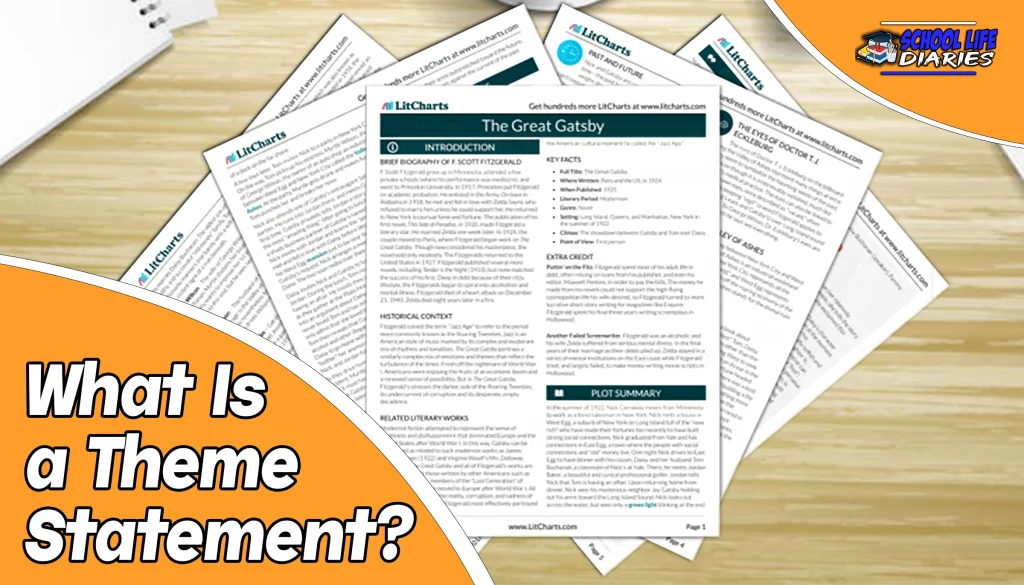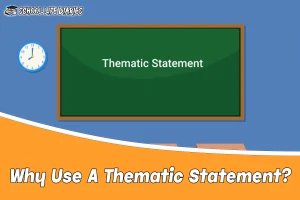A theme statement is a central idea or message that a writer conveys in their work. It serves to capture the essence of the story and provide readers with an understanding of its meaning. In many cases, it reflects the writer’s opinion on some matter of life or society. This statement captures the idea that courage and determination are essential elements of success. By expressing this statement, the writer conveys a message about what they believe it takes to achieve greatness.
Theme statements also serve as guides in literature and other forms of writing. For example, they help writers develop plot and character development. By choosing a theme statement to focus on, the writer can begin exploring ideas that relate back to it. This allows them to create an interesting story that conveys their thoughts on a given topic in an engaging way.
Theme statements also play an important role in how readers interpret works of literature. By recognizing the statement and connecting it to their own experiences, readers can gain a deeper understanding of the story and its meaning. This helps them draw connections between the characters, plotlines, and themes of the work in order to uncover key messages that may have been overlooked.
How To Write A Theme Statement?
Consider the following advice to help you write a comprehensive theme statement:
1. Consider the Author’s Perspective:
Writing a theme statement requires one to consider the author’s perspective and intentions when writing their work. This means examining not only what the author has written, but also why they chose to write it in such a way. It is important to look at any outside sources or influences that may have shaped the perspective of the author and their writing.
Follow these steps to consider the author’s perspective when writing a theme statement:
– Analyze any outside influences that may have shaped the author’s intentions and point of view
– Construct a detailed theme statement that accurately represents the author’s intentions and perspective.
2. Analyze the text:
When writing a theme statement, it is important to carefully analyze the text to identify any underlying conflicts and central ideas. This involves considering the author’s perspective and looking for clues that may suggest a particular meaning or message. Furthermore, it is important to understand how the different elements of the text such as the characters, setting, plot, and language contribute to the overall story.
3. Identify conflicts and central ideas:
When analyzing a text, it is important to identify any underlying conflicts and central ideas. This helps to determine what the author may be trying to say about a particular topic or situation. To do this effectively, consider how different characters interact with one another and how their choices may contribute to the development of the story.
4. Consider the author’s perspective:
When writing a theme statement, it is important to consider the author’s perspective. What point of view is he or she trying to convey? Does this suggest any particular ideas about a certain issue? Consider how the narrative is structured and how different elements are used to convey a particular message or theme.
5. State the theme:
Once you have identified any underlying conflicts and central ideas, as well as considered the author’s perspective, it is time to state the theme of the text. This can be done by summarizing the main idea of the text in one concise sentence. This should provide a clear and concise statement that encapsulates the message or meaning of the text.
6. Edit for clarity:
It is important to edit your theme statement for clarity. Make sure that the language used is understandable and that the message being conveyed is clear. Double-check any information or facts included in your theme statement to ensure accuracy and precision.
What Is A Thematic Statement?
A thematic statement is a sentence or phrase that encapsulates the main idea or theme of a text. It expresses the core message that the author wants to communicate to its readers. Thematic statements are often found at the beginning or end of works but can be located throughout a text as well.
It can be used to provide structure, help the reader grasp the main point, and provide a sense of closure. Thematic statements are also used to create connections between texts, as they can be used to compare and contrast different works.
By reviewing thematic statements, we can gain insight into an author’s intent and meaning behind their work. It is important to remember that not all authors will explicitly state their thematic statement, as it may be implied or suggested in the text.
Why Use A Thematic Statement?
A thematic statement is a powerful tool that can be used to effectively communicate and convey a specific message or concept. It acts as a focus for an essay, speech, advertisement, novel, or any other form of communication. A thematic statement is an effective way to create coherence and unity within your written work.
By using one single idea or concept, a thematic statement is able to unify your text and give it purpose. It clarifies the main point you are trying to make and helps readers to better understand your work. To create an effective thematic statement, keep some key points in mind.
Ensure that your statement is clear and concise; use language that can easily be understood by your intended audience. Make sure that it is specific enough to capture the essence of what you are trying to convey.
Ensure that it can stand alone as a sentence and does not require any additional explanation or clarification. With a little practice, you can create effective and powerful thematic statements that will help communicate your ideas and messages clearly.
Is The Theme Statement Important?
The theme statement is incredibly important for any message, as it serves to define the main point of the communication. It encapsulates the core idea or concept and provides a succinct summary of what will be discussed. A well-crafted theme statement can help guide readers through complex topics and provide a sense of direction for any conversation.
A strong theme statement should be concise, direct, and memorable. It should also align with the overall message of the communication and capture the audience’s attention. To ensure your statement is effective, it’s important to consider who you are speaking to and what sort of language they will respond best to.
5 Powerful Thematic Statement Examples
Example 1:
“The power of the individual to influence and shape society is undeniable; we can see countless examples throughout history of individuals who have made a lasting impact on their communities. As individuals, we each have the potential to make a difference in our own communities. Whether that means volunteering at a local shelter, organizing a fundraiser for a worthy cause, or speaking out against injustice, each of us has the power to be an agent of change.”
Example 2:
“It is important to remember that while individuals can have an impact, real and lasting change requires collective action. In many cases, the power of a group working together can be much more effective than any individual effort alone. By combining our resources including time, energy, and money. We can create a larger and more impactful force for good. We also have the opportunity to collaborate and learn from one another, sharing our unique perspectives and pooling our collective wisdom. When we come together in solidarity, we empower ourselves to create a better future for all.”
Example 3:
“We all have the power to help bring about positive change in our communities; it is simply a matter of finding ways to use our individual and collective strengths for the greater good. Whether that means organizing a protest, running for office, or simply donating to an organization you believe in, each of us can make a difference if we choose to do so. By banding together with others who share our vision and values, we can create powerful and lasting change in the world around us.”
Example 4:
“At the end of the day, it is up to each and every one of us to make a conscious effort to help create a better future. We can start by taking small steps within our own lives educating ourselves on issues that matter, supporting local causes we care about, and committing to making a positive difference in our communities. By utilizing the power of individual and collective action, we can work together to create a more just and equitable world for all.”
Example 5:
“No matter how big or small the impact, every effort counts when it comes to creating lasting change. We have the opportunity to come together and use our individual and collective strengths to create a better future for all. So let us not forget that each of us has the power to make a difference let’s get out there and do it”
Tips For Writing A Theme Statement
1. Ask What the Writer Believes:
To craft a meaningful and engaging theme statement, it is important to ask what the writer believes in terms of the characters, plot, and themes that they are exploring in their work. This will help you tap into the deeper meaning behind your story and create a powerful statement that speaks to readers.
2. Be Descriptive Instead of Prescriptive:
When writing your theme statement, you want to take a descriptive approach instead of a prescriptive one. By taking this approach, you will be able to create a theme statement that is specific and meaningful.
3. Discern Changes in the Characters:
One of the best ways to craft a powerful theme statement is by looking at the changes that occur within your characters throughout the story. This will help you identify any patterns or themes that may be present, allowing you to accurately capture their development in your theme statement.
4. Understand the Story’s Message:
When crafting a theme statement, it is important to understand the overall message behind your story. Is the writer conveying a message of hope? Are they exploring universal themes of good vs. evil? Understanding this will help you create a more focused and meaningful theme statement that resonates with readers.
5. Identify the Conflict:
Conflict is an essential part of any story, and examining it closely can be a great way to uncover deeper themes that may be present. Looking at how characters interact and the obstacles they face will help you find connections between plot points and identify potential themes that could be explored in your theme statement.
6. Show How the Theme is Developed Over Time:
To craft a powerful theme statement, you want to make sure that it accurately reflects how the theme evolves over time in your story. Showing how the characters and events lead up to the climax of the story and how this builds on the themes explored throughout can help create an engaging and meaningful theme statement.
7. Find Connections Between Characters and Events:
A great way to craft a powerful theme statement is to look for connections between characters and events in your story. This can help you identify patterns or commonalities that might not be immediately apparent.
8. Focus on Specific Words or Phrases that Help Define Your Theme:
When crafting a theme statement, it can be helpful to identify specific words and phrases that help express the overall meaning of your story. This will ensure that you create an engaging and meaningful statement that resonates with your readers.
Good And Bad Theme Statement Examples
Good Theme Statement Examples:
– Gym owners can take their businesses to the next level with smart investments.
– Learn how gym owners can maximize profits with targeted marketing strategies.
– Discover how to create a thriving gym culture that keeps members engaged and coming back for more.
Bad Theme Statement Examples:
– Don’t waste your money buying into a failing gym franchise.
– Stop spending time on outdated marketing tactics for gyms.
– Don’t get stuck in old habits; learn new ways to run a successful gym today.
Related Article: Term Paper: Structure And Tips For Writing A Successful Paper
Final Verdict:
A theme statement is a concise and powerful expression of the central idea or message that an author is conveying in their work of literature. It serves as a guide for the reader to better understand and interpret the story’s underlying meaning. Crafting a theme statement involves analyzing and identifying key literary elements such as characters, plot, setting, and symbolism, among others.
It can be challenging to distill a complex work of literature down to a single statement, but doing so can offer valuable insights and a deeper appreciation for the author’s work. By understanding the importance of theme statements, readers can enrich their experience and engage more meaningfully with the text.








